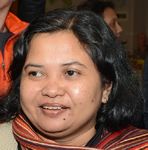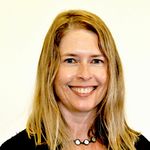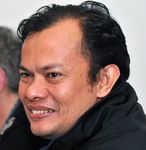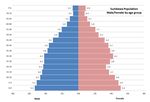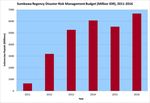SUMBAWA REGENCY DISASTER RISK REDUCTION PROFILE - STIRRRD
←
→
Page content transcription
If your browser does not render page correctly, please read the page content below
SUMBAWA
This profile summarises
the Natural, Built, Social
REGENCY
and Cultural, and
Economic environments
DISASTER RISK
of Sumbawa Regency
and their susceptibility
REDUCTION
to natural hazards. The
Disaster Risk Reduction
initiatives of the local
PROFILE government are also
described.
2016
Villages located close to the coast can be at risk from tsunamis and
more frequent flooding from storm surges and large waves.NATURAL ENVIRONMENT
Sumbawa Regency is located in Nusa
Tenggara Barat (NTB) province,
Indonesia (Figure 1). The Regency
is located on the island of Sumbawa
and covers an area of 6,643.98 km2.
It includes the substantial island of
Moyo, lying off the north coast of
Sumbawa. The capital of the regency
is Sumbawa Besar.
Hazards and Risks
Sumbawa Regency is at subject to many
different types of natural hazards.
Observed events include floods, extreme
weather, drought, extreme waves and
erosion, earthquakes, landslides, volcanic
eruptions, tsunamis and social conflicts. In
1977, a magnitude 8.3 earthquake on the
Sunda Trench created a large tsunami that
caused significant damaged in Sumbawa
and surrounding islands (Gusman et al, Eurasian tectonic plates, makes Sumbawa The alluvial outwash plains are formed
2009). Sumbawa has a BNPB Disaster Risk vulnerable to natural disasters. The Sunda as streams exit their valleys on the island
Index Score of 150 (high) and is ranked Trench, to the south of Sumbawa, can are vulnerable to frequent flooding,
302nd out of the 496 districts assessed experience large earthquakes capable of particularly in the rainy season. Low-lying
(BNPB 2013). generating tsunamis that can affect the coastal areas, where many villages are
region. In addition, the presence of local located, are influenced by coastal processes
Natural Environment active faults north of the island increases such as coastal abrasion, storm surges and
Vulnerability the risk of earthquakes. The island is also tsunamis. The impacts of these coastal
at risk from the effects of future volcanic processes are likely to be exacerbated due
The active geological processes associated
eruptions, particularly ashfall from Mount to future climate change and seas level rise.
with the collision of Indo-Australian and
Rinjani and Mount Tambora.
Table 1. Assessment of risk from hazards for Sumbawa Regency (Disaster Risk Index – 2013).
Extreme Coastal
Threat Earthquake Tsunami Landslide Forest Fire Drought
Weather Abrasion
Risk Moderate High Moderate High High High Moderate
SOCIAL ENVIRONMENT
The population of Sumbawa in 2013
was 431,924. The average population
density of the district is 66 people
per km2. Sumbawa Besar sub-district
is the most densely populated with
UMBAWA
1,327 people per km2. The population
of Sumbawa is predominantly muslim
and hindu.
Youthful Population
Sumbawa has a young population with
over half of the population (53.4%) being
30 years old or younger. Younger people
can be more vulnerable to disasters
however this does present education
opportunities on hazards and risks
through schools. In addition, social media
is a good education platform for children
and young adults.
Source: Sumbawa Regency in Figures 2015.V1.1
ECONOMIC BUILT ENVIRONMENT
ENVIRONMENT Loose land use planning and control
There is no land use planning that identifies and restricts or
Catchment Management reduces infrastructure development or buildings in natural hazard
Deforestation resulting in exposed land which is not replanted areas. As such, many buildings are at risk of flooding and new
is very prone to erosion. Heavy rainfall efficiently moves large locations identified for development do not take either natural
amounts of sediment down the catchment, exacerbating flooding hazards or site ground conditions into consideration. There is little
while significantly impacting properties and infrastructure. The information or data on the specific location of buildings and their
exacerbation of downstream flooding due to poor catchment proximity to high risk natural hazard areas, such as floodplains.
management practices is a concern in Sumbawa.
Poor construction quality of buildings
Many buildings in Sumbawa do not adhere to design specifications
or have been constructed using inferior materials. As such, the
integrity of many structures is not strong meaning they would
likely fail in an earthquake or other natural disaster.
DISASTER RISK REDUCTION CAPABILITY
The budget for Disaster Risk Management
(DRM) in 2016 is 6.6B Rupiah
(USD$506 k) and has on average, increased
since 2011. There is good political support
in Sumbawa Regency for Disaster Risk
Management.
Coordination
While there is a structure to facilitate DRR
activities in place through regulation and
the establishment of the BPBD; education,
training and collaboration on DRR needs
improvement in Sumbawa. Discussions
identified that there is a lack of community
participation and knowledge on DRR
activities resulting in the community
becoming more dependent on government
authorities. A DRR Forum would help
coordination and networking amongst The Local Government – Self Assessment Survey (LG-SAT) diagram summarises the strengths and
stakeholders and would assist with weaknesses of the DRR environment for Sumbawa Regency, August 2015.
stronger strategic planning.
Ownership of DRR
Responsibilities
In Sumbawa, it is not well understood
that government agencies other than
BPBD, private sectors and communities
have a responsibility to implement
disaster risk reduction measures. As such,
DRR activities are not well coordinated
SUMBAWA
or integrated across these groups and
agencies. These stakeholders typically have
the view that disaster risk management is
the sole responsibility of the government
and specifically BPBD.
Lack of Regulations
Results from the LG-SAT survey
indicate that there is a severe lack of
DRR regulation in Sumbawa. It is
important that local regulations that are
developed complements existing national
legislation. In addition, good compliance
Source: BPBD Morowali, 2016.
and enforcement must accompany any
regulations that are implementedABOUT StIRRRD
STRENGTHENED INDONESIAN RESILIENCE:
REDUCING RISK FROM DISASTERS
Sources:
BNPB, 2013. Indeks Rawan Bencana
Indonesia. Badan Nasional
Penanggulangan Bencana, 2013.
BPS 2015: Statistik Daerah Kota
Sumbawa 2015. Badan Pusat
Statistik, Sumbawa, 2015.
Gusman, A. R.; Tanioka, Y.;
Matsumoto, H.; Iwasaki, S. (2009),
“Analysis of the Tsunami Generated
by the Great 1977 Sumba Earthquake
that Occurred in Indonesia”, Bulletin
of the Seismological Society of
America (Seismological Society of
America) 99 (4): 2169–2179.
With funding support from the New Zealand Aid A key part of this involves cementing relationships
Notes from StIRRRD Introductory
Programme, Universitas Gadjah Mada (UGM) is between local government and local universities who
Visit Workshop.
partnering with GNS Science in an Activity which will develop teaching and research programmes in
supports the Indonesian Government to reduce the aspects of disaster risk management to support their local Notes from StIRRRD Preliminary
impacts of natural disasters through increasing the communities. The districts involved in the Activity will Action Plan Workshop.
disaster risk reduction (DRR) capability of local also provide peer support to each other on the learning
Notes from StIRRRD Women’s Focus
government and local universities. The Activity assists journey. The Project is supported by the Indonesian
Group Discussion.
10 districts and associated universities to understand their National Agency for Disaster Mitigation (BNPB) and
DRR issues and priorities, helps develop their capability Kemendesa.
to understand and manage these issues, and then to
develop an action plan and implementation programme.
FOR MORE INFORMATION:
http://StIRRRD.org or
CONTACT:
Michele Daly Dr. Teuku Faisal Fathani Nico Fournier Esti Anantasari
Risk and Society Department Department of Civil and Head of Volcanology Gadjah Mada University
GNS Science Environmental Engineering GNS Science Yogyakarta, Indonesia
Wellington, New Zealand Gadjah Mada University Wellington, New Zealand esti.anantasari@ugm.ac.id
m.daly@gns.cri.nz Yogyakarta, Indonesia n.fournier@gns.cri.nz
tfathani@ugm.ac.idYou can also read




